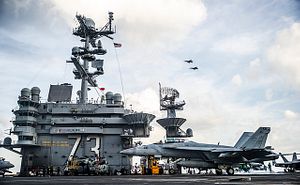In 1957, Hans W. Weigert, then a professor at Georgetown University, and five colleagues wrote Principles of Political Geography, which attempted to show “the interrelationship and the blending of political and geographic factors in power relations” across the globe. Although it was written at a time when the United States and the West faced the Sino-Soviet bloc based in the geographical “heartland” of the Eurasian land mass, Weigert’s analysis of the geographical features of the East Asian coast and its marginal seas continues to have relevance to current international relations, especially the ongoing struggles for power in the South China Sea and U.S. efforts to either contain China or act as an offshore balancer of the Asia-Pacific region.
Weigert was born in 1902 in Berlin, Germany. Originally a lawyer, in 1938 he fled Germany for the United States as war clouds gathered over Europe. He went on to teach at Trinity College, Carleton College, and the University of Chicago. During the Second World War, Weigert wrote a book on German geopolitics, Generals and Geographers: The Twilight of Geopolitics (1942), which analyzed the writings of Karl Haushofer and other German geopoliticians, and edited a symposium on geopolitics entitled Compass of the World (1944). He also wrote articles and reviewed books on geopolitics and international relations in The Saturday Review, Foreign Affairs, and Harper’s Monthly. After the war, Weigert served with the U.S. military government and High Commission in Germany.
Weigert’s geographical pattern of the East Asian coast in Principles of Political Geography focused on the location of marginal seas and narrow waterways that, he wrote, “rank high among the geographical foundations of political and military power.” These marginal seas and narrow straits, he explained, “control vital sea communications of the world and are likely to be pivotal areas in any conflict” between East Asian land powers and Western sea powers. So long as the sea powers maintain “intermediate bases” along the East Asian coast, “they function as a cordon sanitaire” of Asian mainland powers. If, however, the sea line of communications is breached by Asian coastal land powers, “the entire peripheral strategy” of the United States “would be endangered.” “The development of air power,” Weigert explained, “has not reduced the importance of these sea and communications focal points, but it has made them more difficult to defend.”
A “strip map” of the East Asian coast from the Bering Sea to the Indian Ocean (which Weigert included in the book), reveals a succession of marginal and enclosed seas that separate the continental mainland from the open oceans. This geographical pattern, Weigert explained, enables sea powers to contain the Asian continental powers by establishing bases and/or supporting allies on the “curving peninsular and island barriers.” “These loop-like barriers,” he wrote, “. . . not only define and separate the marginal seas but lead to a sequence of straits and narrows that have great strategic significance.”
To the extreme north, the Asian coast approaching the Bering Sea is geographically blocked by the curving Aleutian Islands. Next, the coast approaching the Sea of Okhotsk is blocked by the Kamchatka peninsula and the Kurile Islands. Further south, Sakhalin Island and the Japanese main islands serve to block the coast along the Sea of Japan. The coast of mainland China (and Indochina) along the East China Sea and South China Sea is blocked by the Ryukyu Island chain, Taiwan, the Pescadores, the Philippine Islands, Borneo, Malaysia, and Indonesia.
Within the marginal seas are narrow waterways or straits that connect the Indian and Pacific Oceans; Weigert mentioned the Strait of Malacca, the Sunda Strait, the Singapore Strait, the San Bernardino Strait, the Surigao Strait, the Lombok and Macassar Straits, and the Torres Strait. Weigert called these narrow passageways “strategic waterways” and “maritime highways.” Control of some or all of these strategic “chokepoints” by naval and air power is crucial to any U.S. effort to contain China or act as the offshore balancer of the East Asian mainland. As Weigert wrote in 1957, “Geography endows with great advantages powers whose naval strength, supported by air bases, controls the marginal seas and narrow passageways, as long as this control is not challenged successfully by naval and air power based on the Eurasian Heartland or rim lands under its control.”
China today gives every indication that it plans to challenge the U.S. peripheral positions along the East Asian coast and become the predominant land, naval, and air power in the Asia-Pacific region. It is this development, more than any other, that is responsible for the ongoing U.S. pivot or rebalance to Asia. It is here that the most important geopolitical great power competition will occur in the 21st century.
Hans Weigert’s geographical pattern points the way to a successful U.S. strategy of containment or offshore balancer.
Francis P. Sempa is the author of Geopolitics: From the Cold War to the 21st Century (Transaction Books) and America’s Global Role: Essays and Reviews on National Security, Geopolitics and War (University Press of America). He is also a contributor to Population Decline and the Remaking of Great Power Politics (Potomac Books). He has written on historical and foreign policy topics for Joint Force Quarterly, American Diplomacy, the University Bookman, The Claremont Review of Books, The Diplomat, Strategic Review, the Washington Times and other publications. He is an attorney, an adjunct professor of political science at Wilkes University, and a contributing editor to American Diplomacy.

































